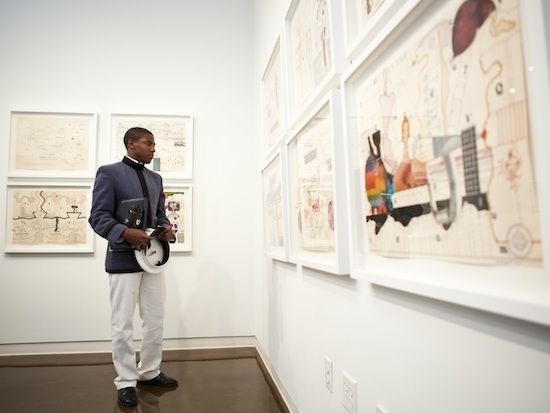Halsey Institute of Contemporary Art profiled on NEA website

The Halsey Institute of Contemporary Art at the College of Charleston was recently awarded a $40,000 grant from the National Endowment for the Arts to support an artist residency and exhibition of works by African-American vernacular sculptor Lonnie Holley. The project includes an exhibition of several dozen of Holley’s works, a site-specific installation using found materials from the Charleston area, and the production of a documentary video. The exhibition is scheduled for fall 2015.
The NEA posted a profile of the Halsey Institute:
The Halsey Institute of Contemporary Art may be housed in a modest suite of gallery and office space on the College of Charleston campus, but its reach far exceeds its physical footprint. With a primary focus on artists “in the margins,” as Chief Curator Mark Sloan puts it, the museum shines a spotlight on artists who, given the depth, quality, and imaginative impact of their work deserve to be much better known. As we learned when we spoke with Sloan by telephone, the Halsey deploys a number of strategies to support the artists it shows. Artists receive not only time and space to work at the Halsey in an artist residency, but the considerable resources of the College of Charleston faculty and staff as well as the Charleston community-at-large are available to support the artist’s vision, whether that means technical expertise, help in the studio, participation in conversations with the artist and other events, or even a place for the artist to live while in town. In addition, the organization produces high-quality educational and outreach materials around the artists and their work, including short films, catalogues, and an expansive online presence on the Halsey website. The Halsey recently received an NEA grant to support an exhibit on the work of visual artist and musician Lonnie Holley. In his own words, here is Mark Sloan on the Halsey’s artist-focused curatorial philosophy, the museum’s plan for the Holley exhibit, and how the artists they feature are a little like snowflakes.
On the curatorial philosophy of the Halsey Institute of Contemporary Art…
We have an eclectic program, focused on showing the work of emerging and mid-career artists. We have developed something of a sub-specialty of showing the work of older, oddly overlooked artists. I think a way to characterize our program is that we’re shining a light in the margins where no one else is really even looking. We don’t pay any attention to who’s hot at Art Basel Miami or who’s selling. We’re happy to look at artists and look for artists who are producing really interesting, challenging, difficult work, but that exist outside of the mainstream art world. That’s not to say that we don’t show artists with art-world stature such as Jasper Johns, Shepard Fairey, Leslie Dill, Nick Cave but by showing those artists alongside artists like Aldwyth or Pat Potter or Don ZanFagna or Aggie Zed, we’re bringing attention to and I’m actually raising the level of appreciation for this work.
I like to think of us as being a generative facility. We very rarely take traveling shows. We originate everything we do. And I think that’s unusual for a university gallery of our size. What we do is we generate collaborations. We’re in it for the long game, and hope that the work we do will contribute to the global conversations about contemporary art.
On choosing artists to show at the Halsey…
I don’t work in a vacuum. Though I’m Chief Curator, I don’t just say by executive fiat, “We’re going to do this.” I’m in conversation with a lot of people, a number of colleagues, locally, regionally, nationally, and internationally as well, certainly, my staff, my board. The very best source for me for artists that I end up showing are artists that I’ve previously shown or worked with. I do an official ceremony after they’ve shown here. I deputize them as adjunct curators of the Halsey and their job is to find and root out the very best artists there are and to let me know about ones that they think might be good for our program. For example, through an artist named Marcia Cohen, I found an artist named Patricia Potter who is in her late seventies and lives in a tree house she built in the wilderness of northern Alabama. Her work is a little like Joseph Cornell on steroids. It’s incredible work. And, again, she’s never really had much exposure. Her January 2015 show here will be her first solo museum exhibition.
Read the complete profile on the NEA website.
Image: Pulse Dome Project–Art + Design by Don ZanFagna, October 19-December 8, 2012

